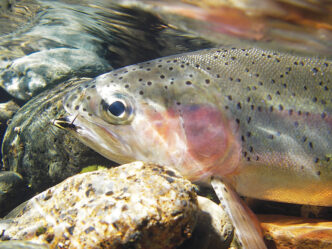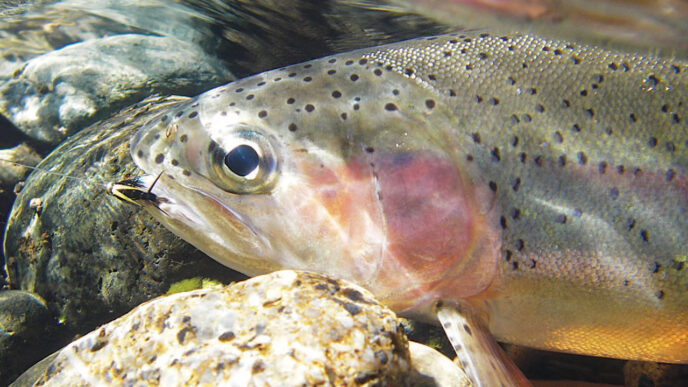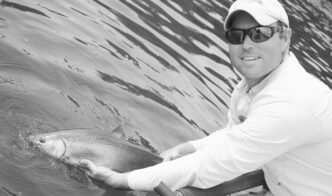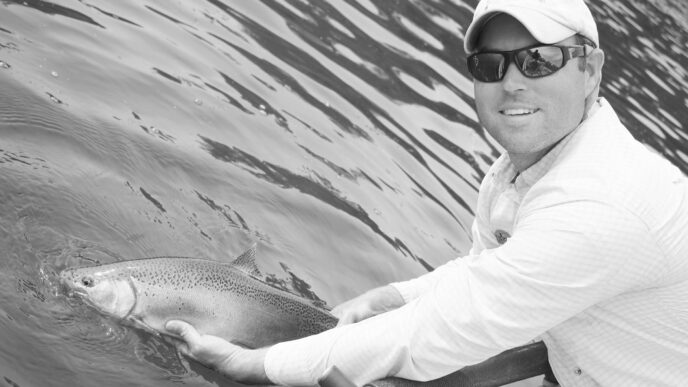Some people have just got to fish, and some people love fishing so much they just have to get others involved. Al Quattrocchi — Al Q to just about everybody — preaches fly fishing the Southern California surf to the unconverted and the faithful alike. He’s more than just “your ordinary obsessed saltwater fly-fishing knucklehead,” as he describes himself on his blog, Flies, Sand, and Surf (http://alquattrocchi.wordpress.com/tag/al-quattrocchi). Al Q is one of the creative directors of a graphic design firm serving the entertainment industry, and he brings his promotional skills to advancing the sport. He teaches fly fishing the surf, gives programs at club meetings throughout the area, posts about his angling on social media, and promotes fly fishing in Southern California via events such as the Double Haul Ball, the One Surf Fly competition, and the Carp Throwdown. His energy inspires others. Like the ocean that draws him to it, Al Quattrocchi is a force of nature.
Bud: What is it with East Coast Italian guys and the Southern California surf? First it’s Nick Curcione, and now you. Fly fishing the Pacific surf doesn’t exactly date back to Theodore Gordon, Frederic Halford, G. E. M. Skues, and Dame Juliana Berners. What brought you to Southern California, what brought you to fly fishing, and what brought you to fly fishing the surf?
Al Q: I developed my love for surf fishing in Brooklyn, New York. My formative years were spent in Sheepshead Bay, which was a metropolitan fishing port that at one time hosted the largest commercial fishing fleet in the world. To put it into historical context, Babe Ruth used to fish on party boats out of Sheepshead Bay. I have lived near the sea my entire life. As a kid, I used take the bus down to the bay with my fishing rod. I would buy a can of Puss ’n Boots seafood-flavored cat food and wait for the party boats to leave the dock, climb down under the piers between the pilings, and chum and snag herring two at a time. I would sell a bucket of herring for five dollars to the party boats for bait.
When I got a little older, I worked and fished the inshore wrecks on my favorite party boats out of Sheepshead Bay for blackfish, porgies, and sea bass. To cover the cost of my trip, I would forfeit my catch to the captain of the boat, who then sold the fresh fish on the pier. Living near the bay allowed me to escape from the concrete sidewalks of the city.
I spent summers with my family living in our seaside bungalow in Breezy Point. For a young fisherman, Breezy Point was as close to heaven as you could get. It was only 13 miles from my home in Brooklyn, but it seemed like a million miles away. Breezy Point is technically the westernmost point of Long Island (the other end, opposite Montauk Point). It’s a long, narrow peninsula that is surrounded by water — Jamaica Bay is to the north, and the Atlantic Ocean is to the south. The narrow west side has a jetty that extends out into the Atlantic and looks straight across to Sandy Hook, New Jersey. The Breezy Point jetty was and still is considered one of the premiere fishing spots in the New York metropolitan area. If you were fishing for stripers on the bay side, you would likely see the parachute ride from Coney Island over the distant horizon. It’s about as close to the city as you can get.
Living in Breezy Point was like attending a surf-fishing academy. It was a blue-collar summer destination with great angling. I became obsessed chasing bluefish and striped bass with plugs and bucktails all over the island. I always had my surf rod rigged and ready, leaning on the wooden porch of our bungalow where we lived. Once the birds started working the beach, everyone would drop what they were doing, grab surf rods, and run down to the beach to cast to the big schools of blues and bass that would push bait onto the sand.
Seeing bluefish blitzes as a kid changed me and made me obsessed with fishing the surf. I was very fortunate to be able to fish with all the local old-timers or sharpies, because they held the key to the knowledge of the surf-fishing universe. These guys knew what the fish were feeding on, the wind, and the tide. They were the original Internet! They would give you just enough information to keep you coming back for more. They took in a bright-eyed skinny Italian kid under their wings and taught me to respect the ocean, and I will forever be grateful for that gift they gave me. This is what compels me today to pay forward that knowledge to the next generation.
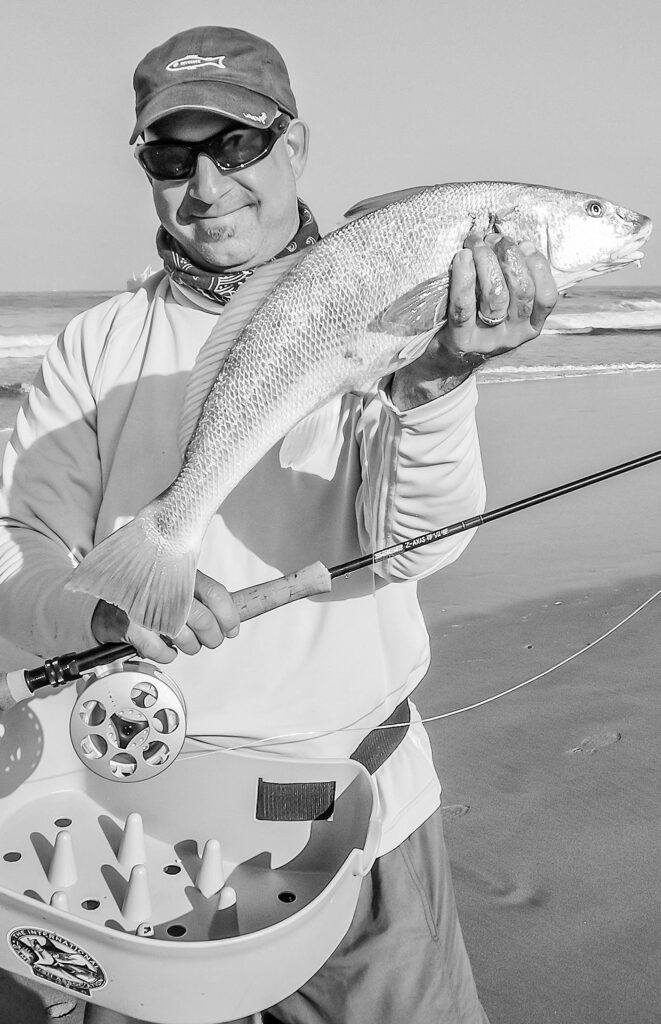
As a teen, I would read every magazine I could afford about saltwater fishing, especially the Saltwater Sportsman when Frank Woolner and Henry Lyman ran it and the Long Island Fisherman for all the local fish reports. I knew all the old saltwater writers by name the way sports junkies memorize baseball, basketball, or hockey players. Writers such as Lefty Kreh, Al Reinfelder, Al Ristori, Milt Rosko, Mark Sosin, Spider Andresen, Frank Fallon, Lou Tabory, Ed Jaworoski, and Nick Curcione were just a few, and the list went on and on. These guys were my heroes, and their stories allowed a kid from the city to travel through his imagination to distant waters and fish for exotic species.
In the spring of 1977, my uncle sent our family of six plane tickets to visit him in Playa del Rey, California, for Easter break. My parents fell in love with sunny California. I remember how cool it was to see palm trees. My dad came back out to Los Angeles that summer to look for a job and was fortunate to choose from three offers. That fall, my family sold everything except their clothes and left Brooklyn for Playa Del Rey, which is adjacent to Marina Del Rey.
I stayed back to complete my senior year in high school. I lived with my grandparents while my parents, two younger brothers, and younger sister built a new life in California.
When I came to California, I decided to pick up a fly rod. The first step that really shaped and made me the surf fly fisherman I am today was a class I took at UCLA called The Art and Science of Fly Fishing with the late and great Neal Taylor. Neal was a great angler and tournament caster. I told Neal I was taking his class only to learn how to cast a fly rod so that I could use it at the beach. He thought I was crazy, but understood.
I met my East Coast fly-fishing buddies after I moved to California. While attending Loyola Marymount University in the late 1970s, I kept hearing a name popping up around campus that seemed familiar to me. It was Nick Curcione, a professor who specialized in the study of deviant behavior and criminology. He was the guy I had been reading articles about in Saltwater Sportsman as a kid in Brooklyn. I couldn’t believe it. It was years later that we finally met, face to face at an alumni barbeque, and instantly we became buddies due to our East Coast roots. I told Nick I wanted to learn more about fly fishing in the surf, and he graciously mentored me and took me under his wing. That was the beginning of a great journey, and it got better.
I remember walking into Marriott’s fly shop in Fullerton and seeing a sign that said “Fly fish with Lefty Kreh at Hot Creek Ranch.” I signed up immediately for this opportunity to meet another one of my heroes and a legend of saltwater angling. This class was in the eastern Sierra, and I was able to spend quality time with the man, one on one. Lefty was gracious. He worked with me on my double haul, and we talked about saltwater fly fishing over the next three days.
I mentioned to Lefty that I had recently seen an American Angler magazine with really cool flies on the cover. They were epoxy flies that represented all the baits I grew up with as a kid. Not only did Lefty know who created the flies, but they were friends. Those flies were created by Bob Popovics from Seaside, New Jersey. Bob had just completed a tying video of his innovative patterns that he was submitting to Umpqua. Lefty offered to send me the tape with all of Bob’s new patterns on it. For a fly tyer, that was like being given the Holy Grail. I had to be the first guy on the West Coast tying Surf Candies with epoxy. I still have that VHS tape. I shared it with Nick, and we are both blown away with Bob’s work.
The following spring, Nick, who was working for Orvis, invited me to go to the famous San Mateo fly-fishing show, the International Sportsmen’s Exposition. At the show, I explored the different venues while Nick worked at his booth. When I returned, he said “Hey Al, your buddy is here, and we are having lunch with him.” I didn’t know who he was talking about. Nick then said, “Popovics is here, and we are having lunch with him.” Are you kidding me? It was the first time we both met Bob, and we immediately became friends. That lunch was the beginning of a mentoring relationship that took me further on my wonderful journey into saltwater fly fishing. It was these friendships with the greatest in the business that upped my learning curve light years and gave me the tools to pass forward to others.
Bud: What differences are there between East Coast and West Coast saltwater angling? And Breezy Point really got whacked by Superstorm Sandy. Do you still have roots there?
Al Q: When Hurricane Sandy hit, it was very personal. I had many close friends still living in Breezy at the time, and some lost everything they had. I haven’t been back there since the storm. I want to keep my fond memories intact.
The most obvious difference between West Coast and East Coast surf fisheries is that the East Coast still has healthy estuaries that produce tons of baitfish and fry that feed the ecosystem. California has dammed up most of its great rivers and filled in most of its estuaries with expensive real estate and land developments, all of which has suffocated the amazing coastal fishery it once had. Don’t get me wrong, there is still great fishing on the West Coast, but it is a shadow of its past, based on what I have read.
On a positive note, the West Coast hosts a year-round fishery, unlike the East Coast, which may get only three-quarters of a year. Shooting heads were developed out here and are still the outfit of choice, whereas on the East Coast, you will fish more intermediates and floating lines in the surf, due to the type of baits that get pushed close to shore by the most common schooling predators, bluefish and striped bass.
Bud: You’ve become an evangelist for surf zone fly fishing in Southern California, giving programs about it in clubs, writing about it in magazines (including “Fly Fishing the Surf 101” in this issue of California Fly Fisher), and, with Jim Solomon, hosting an instructional “surf boot camp” to develop fly fishers’ surf skills. You outline the basics of fly fishing the Southern California surf in that article, but there’s a lot more that a surf fly fisher here needs to know. For example, while surfperch can be pushovers (if they’re there, they likely will eat your fly, if you can get it in front of them), corbinas are a whole ’nother story. What does a Southern California surf angler need to know about targeting these fish? And what about other species?
Al Q: Yes, Jim Solomon, one of my fishing buddies, and I pride ourselves on teaching people to fly fish in saltwater. We team up doing presentations at the clubs and on the beach. Jim is an accomplished freshwater fly fisher and a Federation of Fly Fishers master instructor. Together, we run the Double Haul Ball, an annual free day to learn to fly fish in salt water held at the historic Long Beach Casting Club. The programming is always informative, and the event is well attended. The Double Hall Ball is filled with FFF casting instructors, fly tyers, and clinics taught by many of our local fly-fishing friends. The event was originally started to help anglers wanting to participate in the One Surf Fly competition. We use our individual strengths together to create programs that can round out an angler. It’s our way of giving back and growing our fishing community. Jim and I are currently working on a new program called The Fly Zone for anglers pursuing sight-fishing adventures. We are also consulting with the Southwest Council of the Federation of Fly Fishers and its president, Michael Schweit, to build a saltwater fly-fishing program for youth that will fall under the umbrella of the One Surf Fly educational series.
The topic of other species is an article unto itself. I’ll have to pitch it to the Editor and Publisher — there’s just too much to get into here. The corbina surf fishery is one of California’s best-kept secrets — a world-class fishery right at our urban doorstep. Corbinas are hands down one of the most challenging fish to catch on a fly in the surf. It’s sight fishing, and I can’t wait till June and July, when the corbinas start crawling around in skinny water and we get them to eat our flies. We have introduced many new anglers to the exciting corbina sight-fishing scene over the years, and the sight-fishing scene has gone through a renaissance over the past decade.
The group of anglers I fish with, affectionately known as the Corbina Patrol, also catch many exotics such as white seabass, striped bass, spotfin croakers, sargos, halibut, and sharks. This is what makes fly fishing the surf so cool — you never know what might eat your fly and take you for a ride.
Bud: Both your education and your day job are in advertising design, and you design flies for the surf. Your Sand Crab and Corbina Candy are about the most realistic mole crab imitations I’ve seen, but other designs, such as your Beach Bug, are more impressionistic. As a professional designer, what insights do you bring to fly design?
Al Q: I treat fly design the way I treat graphic design. Less is more. I try to keep my flies simple, visually appealing, and fishable. What I learned from tying flies with Bob Popovics is to study the baits, both above and below the water. Watch the way they move, their sizes and colors, and then try to represent them in a simple and functional way. The imitations don’t have to be perfect, they just need to imitate the size, color, and movement of bait. They should look natural in the water. Flies also should cast easily and not foul. And they need to be durable when fishing in the surf.
I always test my flies by casting them in a pool or off a pier and watch the way they move or swim when I strip the fly. This information is important, especially if you fly fish at night and can’t see your flies in the water. It always gives me confidence — I don’t have to assume what’s going on at the end of my line. Flies are like snowflakes, everyone is different. Watching your flies move in water when you strip them is a big deal. I have had tarpon guides watch a fly in the water and immediately change it because it wasn’t moving naturally. I always swim my flies before fishing them. You would be surprised how swimming your flies will make you a better fly tyer and angler.
Bud: You’re involved in a couple of friendly fly-fishing competition events, the One Surf Fly and (with Conway Bowman) the Carp Throwdown at Lake Henshaw. Some fly fishers view competitions (and indeed, competition itself ) as alien to the sport. What attracts you to them, and what do you say to those who recoil from these sorts of events?
Al Q:I don’t look at them as competitions, I look at them as fun, as social occasions for birds of a feather to flock together, and as ways to help promote the sport. I never intended The One Surf Fly to be a serious competition — it was designed just to be a fun event. The One Surf Fly is based on the premise of bringing people together on the sand to celebrate fly fishing the surf as a community. It’s like the national holiday for our saltwater fly-fishing community. Everyone walks away from this event happy. We try to bring together older anglers with younger anglers who are looking for mentors.
Each angler brings a fly — one fly. We collect the flies and at random, each angler picks a fly just 15 minutes before the event starts. A seasoned angler may get a fly he or she hasn’t fished with, and a newbie could get the hot fly and catch more fish. We award three trophies, one for biggest fish, one for most fish, and one for the first fish caught. Everyone has a great time while we raise money for worthy causes. Each event partners with a fly shop near where we fish. A world-class raffle sponsored by our generous friends in the industry benefits a local nonprofit organization. It’s a win-win for all. Anyone can visit www.onesurffly.com for updates to next year’s events.
When Conway Bowman and I decided to do a carp tournament, the Carp Throwdown needed to be a little different, because it is a completely different fishery. We chose Lake Henshaw because it is very isolated, quiet, and is a great carp sightfishing destination. You can rent small boats or wade fish the bank on foot. Lake Henshaw is a very technical fishery. When the winds blow, you need to know how to fish the foam lines and need to put you fly in a very small ring in a second to get a bite. We hold the tournament in mid-June during a grasshopper hatch, when you can get carp to eat dry flies on the surface. How cool is that?
Carp fly fishers are their own breed and very passionate about carp. We usually give out great swag, prizes, and trophies. There’s usually a barbeque the night before, and everyone stays in the rooms right on the lake. It is one of my favorite events of the year. The whole place is locked in a time warp. You feel like you stepped back into the 1950s, when Lake Henshaw was a premiere largemouth bass fishery. Because of poor water management and because this place was allowed to get overrun with vegetation over the years, the bass are few to be found, but the carp have completely taken over. At the awards ceremony, we always make a point to ask the winning anglers what flies they fished and to share their winning strategies so other anglers can learn and come away with a positive experience. Cutthroat competition it ain’t.
Bud: Some of the people I’ve interviewed tend to be a bit reclusive, but you’re all over contemporary social media. Since you have one foot in the entertainment world, I guess that makes sense, and it also points to a question about fly fishing. What role do you see social media such as Twitter and Facebook playing in the future of fly fishing — not just for fly-fishing businesses, but for attracting people to the sport and connecting them with it and with each other?
Al Q: The world is moving way too fast, and I am trying to keep up with the times. I really want to bring younger people into the sport, and social media is way to reach them. I am a visual person, and I really love photography. With today’s technology, I am able share my photos, knowledge, and opinions instantly on my blog. I love it when anglers come up to me in a fly shop or on the beach to comment about something I posted. There are so many good sources of information about fly fishing, if you search for it.
The fly-fishing industry needs to embrace the power of the Internet and not be afraid of it. Facebook has changed the way we interact with each other. We shop, text, blog, shoot video, share the latest surf reports, all on our smartphones. Today, we all carry computers and the ability to see the world in our pockets. It’s crazy how fast our lives are changing daily. We live in a digital era, and we need to embrace it and try to find new and better ways to make it work for us as anglers and business people. Be one with the pixel!
Bud: You and I moved to California the same year, in the late 1970s. Things have changed a whole lot since then, and not just with the rise of the Internet and social media. What changes have you witnessed in the surf fly-fishing scene over the years and in fly fishing in Southern California in general?
Al Q:I have seen an increase in fly fishing the surf over recent years. When I first started fly fishing the surf, there were a handful of guys out there, and I rarely bumped into a single one. Now, whenever I am down at the beach, it is great to see one or two flyrodders. The One Surf Fly event has grown in attendance every year over the last five years, and I hope it has made a difference in exposing new anglers.
Bud: I don’t see a lot of references to trout fishing in what you write. What’s the matter, don’t you have any fine tippets, single malt scotch, and tweeds?
Al Q: I have nothing against trout fishing. I do plaid — no tweeds yet — and I like bourbon as much as single-malt scotch. I love it that bourbon is an original American spirit! I think all fishing fills the soul. Anytime you can get yourself out on the water, relax, and enjoy yourself, whether you are by yourself or with friends, is what it’s all about. It’s not always about catching fish. I tell people that I love to fly fish because it takes me to beautiful places and I meet interesting people. The sea has always been my pond — it’s easily accessible and always teaches me new things. As far as trout go, Jim Solomon has threatened to take me trout fishing with a 3-weight, but I don’t know if I will be able to tie a size 24. But if you plan to join us at the next One Surf Fly in May 2015, San Diego, please do not show up at the beach with a floating line and an Elk Hair Caddis!
Bud: We have arrived at the traditional Silly Tree Question. If you were a tree, what kind of tree would you be?
Al Q: I have given this question some serious thought, and I think I would have to be a mangrove. Here’s the reason. How cool would it be to always be sticking half in and half out of warm turquoise water with warm breezes blowing through your leaves? As a tropical mangrove tree, I would be contributing to the ecosystem by protecting baitfish and harboring predators that could ambush prey when the wind and tides change. It would be like watching the Discovery Channel, and the best part is that I would have a front-row seat to enjoy the show.






